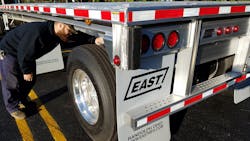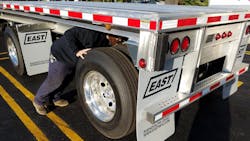Maintenance and inspection tips for platform trailers
Good preventive maintenance practices will help keep any trailer, much less flatbed units, up and running for longer productive time periods.
East Manufacturing recently put together a list of general maintenance tips for flatbed and drop deck trailer owners, though the company stressed that it’s critical to follow the platform trailer procedures offered by the manufacturers of their specific make and models.
East added that the U.S. Department of Transportation (DOT) requires that maintenance records be kept for every commercial highway vehicle and that includes trailers as well.
On a weekly basis, technicians should follow these inspection protocols:
On a monthly basis, some addition maintenance steps need to be taken:
- Check all welds for cracks.
- Inspect the suspension system bushings for excessive wear and freedom of movement. Remove and replace all worn bushings.
- Check the wheel bearings for the recommended adjustment.
- Check fifth wheel plate for corrosion between plate and main rail.
- Check fifth wheel plate and kingpin for tightness.
About the Author
Fleet Owner Staff
Our Editorial Team
Kevin Jones, Editorial Director, Commercial Vehicle Group
Cristina Commendatore, Executive Editor
Scott Achelpohl, Managing Editor
Josh Fisher, Senior Editor
Catharine Conway, Digital Editor
Eric Van Egeren, Art Director

